This one was released last year and I haven't seen a lot posted about it so thought I would do one for us.
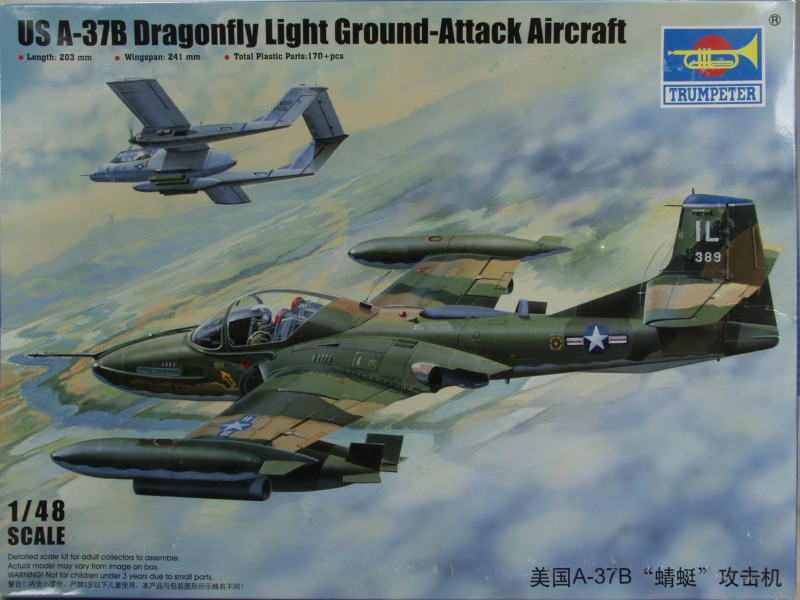
History: The Cessna A-37 was developed from the T-37C, which was built to meet a trainer specification that the Air Force issued in April of 1952. Cessna won the resulting contract to build the trainer and a contract for three prototypes was issued in April of 1954. The XT-37 made its first flight in October of 1954. After a thorough flight-testing program, changes were made and the first production aircraft was delivered to the Air Force during June of 1956 as the T-37A. The T-37B was basically the same airframe with higher-powered engines and improved avionics. During 1961 Cessna began development of an armed variant to be used for armament training. This included a strengthened wing with two pylons, one under each wing. Provision was also made for 65-gallon wingtip tanks. After successful testing with the armament option, the aircraft was ordered into production as the T-37C. With the armament option the aircraft became a candidate for counter insurgency operations (COIN) however it gained firepower at the expense of performance. As an armed trainer it could carry a wide variety of armament and provision was made for carrying Sidewinder air-to-air missiles.
During late 1962 the Special Air Warfare center evaluated two T-37C’s for possible use in the COIN role. Following the evaluation the Air Force decided to develop an improved variant of the T-37C with a greater weapons load, increased range, higher thrust engines and better short field performance. During 1963 Cessna received a contract for two prototypes under the designation of YAT-37D. Changes from the T-37C included two GE J85 engines with more than double the thrust of the original engines, strengthened wings with six pylons for under wing stores, self-sealing fuel tanks, cockpit armor, a nose mounted 7.62mm minigun with 1500 rounds of ammunition, a gun sight, a gun camera, larger wheels and tires, 95 gallon wingtip tanks and a special electronics package for communications, navigation and target acquisition. The first prototype flew in October of 1963.
The Air Force decided the best way to properly evaluate the aircraft would be under actual conditions and as a result placed an order with Cessna for a preproduction evaluation batch of thirty-nine aircraft under the designation of AT-37D. Shortly after this contract was released the designation was changed to A-37A. To speed up the program the 39 aircraft were converted from standard T-37B’s. In August of 1967 twenty-five of the thirty-nine were deployed to Vietnam and flew more than 5000 sorties. They operated in six basic roles; close air support, helicopter escort, combat air patrol, armed reconnaissance, forward air control and night interdiction. Some 3000 sorties were flown without a single loss to enemy fire although twenty-four aircraft suffered hits from ground fire and two crashed in landing accidents.
While highly successful the combat evaluation highlighted a number of problems, most notably lack of range and loiter time. Also there was an issue with severe control loads when carrying weapons at normal release speeds and the lack of redundancy in the primary control runs was another concern. As a result of this the Air Force order the A-37A to be modified to over come these under the designation A-37B.
The kit: The Trumpeter kit comes in their typical top open tray type box with a thin top and corrugated bottom. Inside the box one finds five sprues of light gray plastic. Each sprue with the exception of the two with under wing stores is individually bagged. A small sprue with the nose cap and two other parts are included in one bag almost as it it was an after thought or perhaps to provide for a 'B' version. One sprue of clear parts is wrapped in foam and bagged separately and a fret of photo etch is supplied in another bag and has a protective film on both sides of it to protect from oxidation. The decals are also separately bagged.
The parts have a matte finish and are virtually flash free. There is some parting line seams that will need to be cleaned up on some parts. Most of the airframe parts feature sprue attachment points on the mating surface which lessons the chance of creating a divot when trimming them free. Surface detail consists of nice size for the scale recessed panel lines, recessed fastener detail and some raised detail where applicable. The fastener and rivet detail is very restrained with most of the rivet detail on the control surfaces. The Trumpeter mad riveter spared this one.
The fuselage has some side wall detail molded in and a couple of ejector pin marks as well although it appears that these will be covered by the cockpit tub. The cockpit tub is made from two three part ejection seats and PE harnesses are supplied, separate rudder pedals, control sticks and throttles. An instrument cowl and instrument panel complete the tub and a three part nose wheel well is attached to the forward part of the tub before assembling the fuselage halves. No nose weight is supplied and only a single word "weight" with an arrow pointing to the space in the nose ahead of the wheel is noted in the instructions. The amount required will be up to you to determine and will need to be added before closing the fuselage halves. The instrument panel has lots of raised detail including instrument bezels and internal instrument dials for those talented at painting these up.
The wings have a single full span bottom section and separate upper wing halves. No engine assemblies are provided, just engine faces and exhaust nozzles. There is what I believe to be a speed brake below the forward fuselage that can be positioned open or closed. All of the other flight control surfaces are molded in the neutral position. The horizontal tail surfaces are one piece moldings. There is some limited amount of detail molded in the main wheel bays. The landing gear are reasonably detailed and the wheel and tire assemblies are one piece and are not weighted.
------------------------------------
There is a good amount of fiddly bits supplied for all the various antennas and the FOD covers are PE and can be assembled stored or covering the intakes. The cockpit canopy can be displayed open or closed. Two sprues are provided for under wing stores and these include two each of two different style drop tanks, one type with fins and one type without, two LAU-3 rocket pods, two M117 bombs, two Mk. 81 bombs, two Suu-11 minigun pods and two Suu-14A/A launchers. A chart on the back page of the instructions shows all the load out possibilities. Next lets look at the sprue shots.
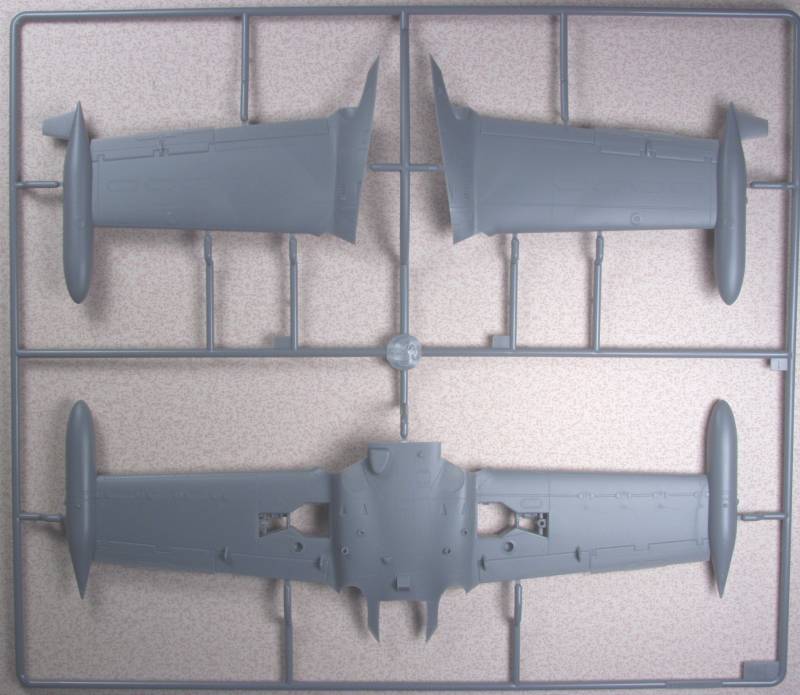
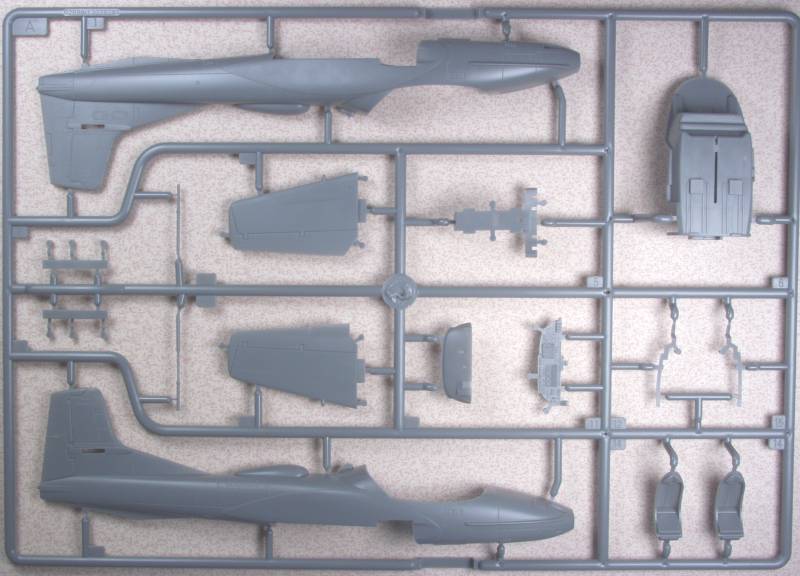
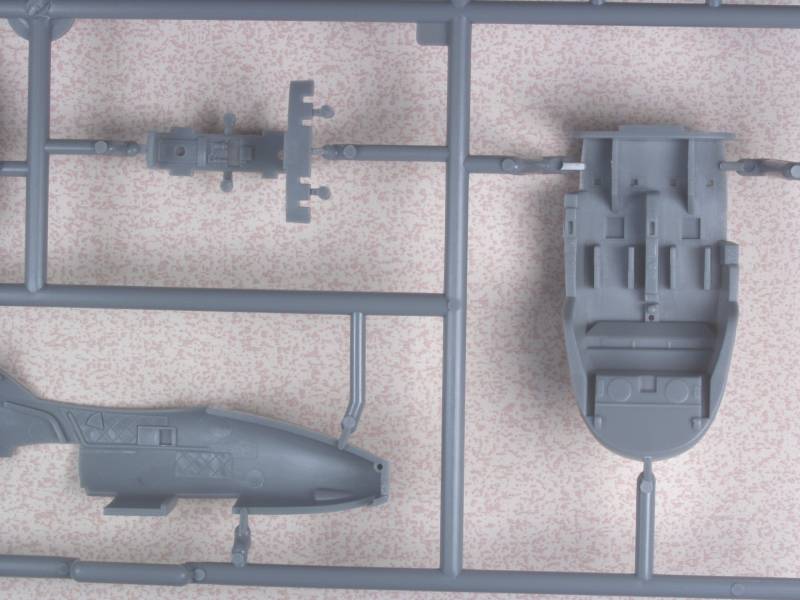
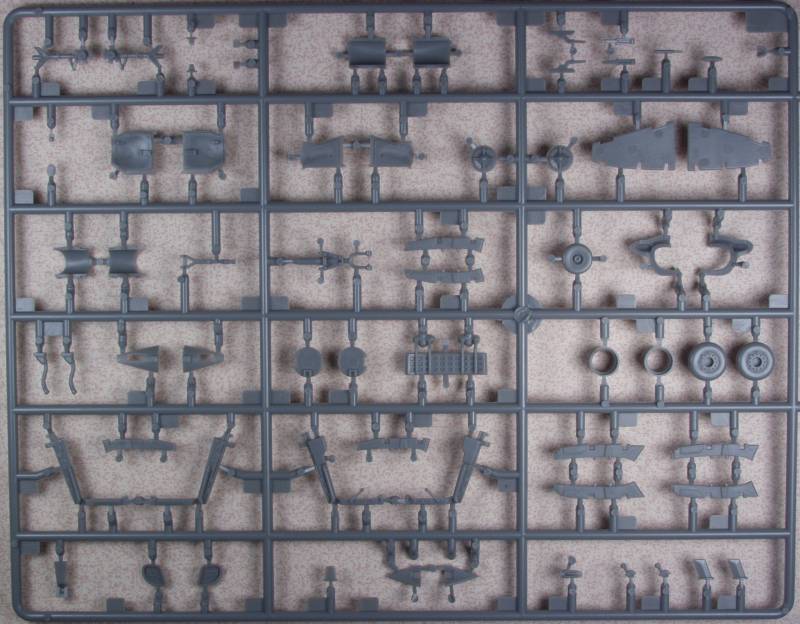
There are two of the next sprue supplied.
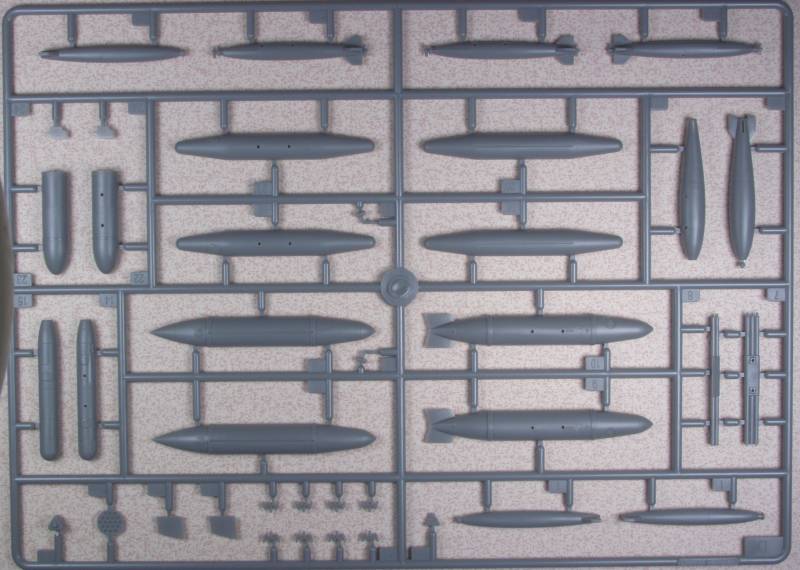

The clear parts are quite clear and have little optical distortion.
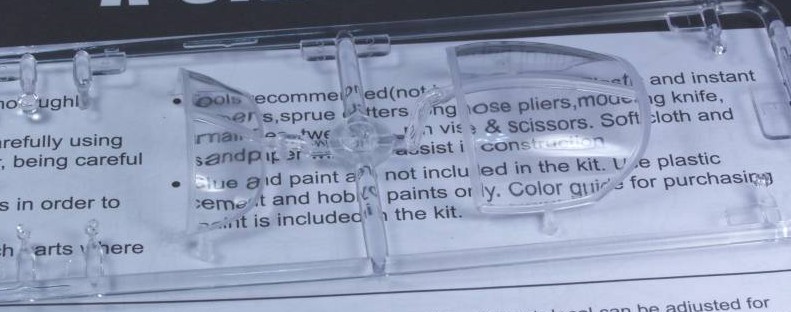
A small fret of photo etch is supplied with belts and harnesses, FOD cover parts and some various parts for the under wing stores.
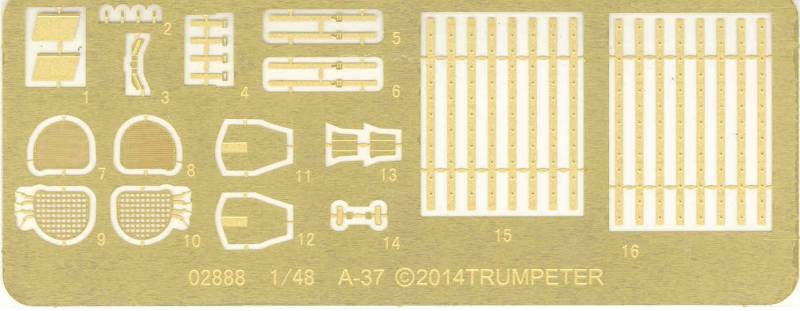
The decals have a semi gloss finish and appear reasonably thin but some have a fair amount of excess clear film around them, a lot of stencil detail is supplied but if you look at the spelling on some of them they either couldn't read their source photo or their interpretation of same wasn't quite up to par. While most look OK the red bar on the national insignia are not centered and the distinguished unit ribbon for the nose is all out of line. There are markings for only one aircraft but keep in mind there were only 37 "A" models made, the vast majority were the "B" model. A second sheet is supplied which has the decals for the under wing stores. Hopefully some after market decals will be produced for this kit.

The instructions are in a landscape format and is a stapled booklet 12 pages in length. There is a parts map and 8 pages of assembly diagrams with the assembly broken into 18 steps. Color call outs are included in each step. For the overall markings and paint a separate page printed on both sides in color is supplied. A color chart on one side calls out the colors by name and Mr. Hobby numbers with references to Vallejo, Model Master, Tamiya and Humbrol if available. The opposite side has the painting and markings for the under wing stores.


Eduard has already produced sets for this kit. The Zoom set is shown below for those of us untalented at hand painting instrument panels in this scale.
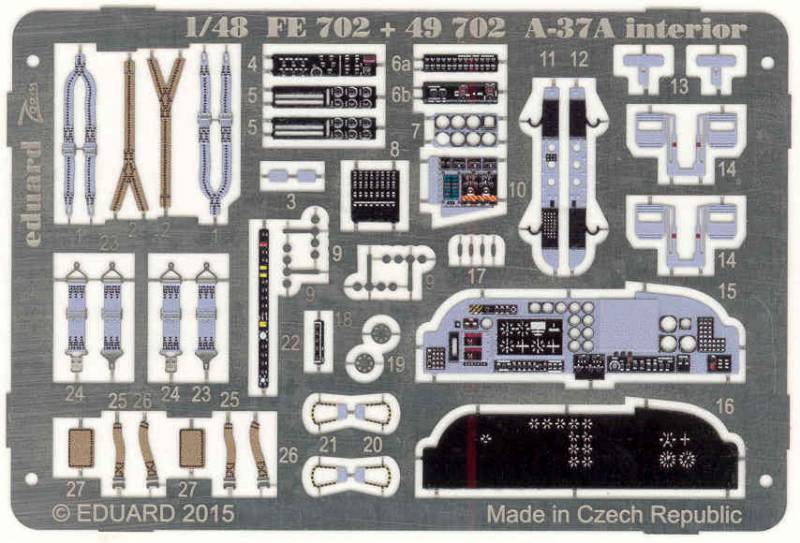
My 2¢ worth: I was a little amazed and disappointed when Trumpeter released this kit. I would have rather seen it in 1/32 considering its size and also considering there is a perfectly acceptable Monogram kit of the "B" model in 1/48 that was recently enhanced by the release from Encore which includes PE. Yeah, I know it has raised detail but it really isn't all that bad. I'm going to assume that unless sales of this kit fall below Trumpeter's expectations that at some point they will release the "B" model as well. Other than the less than stellar decals it looks to be a nice kit and should go together without a lot of fuss. I did not do a test fit as the most likely area to exhibit poor fit will be around the engine intakes and the way the parts are broken down it would be hard to test fit without gluing the parts.
Anyone interested in my take on the Monogram kit can read my review here Monogram A-37B review
Thanks for looking.
